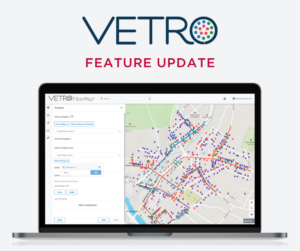In the dynamic realm of internet service provision, the significance of accurate and real-time network inventory and asset documentation cannot be overstated. Beyond a mere best practice, it’s a foundational necessity. This blog post delves into the repercussions of subpar Physical Network Inventory (PNI) data and offers an exhaustive guide on ensuring data accuracy, with a special emphasis on the transformative capabilities of VETRO FiberMap.
The Far-reaching Consequences of Poor PNI Data:
Wasted Spending: Inaccurate records result in redundant equipment purchases, unnecessary maintenance, and overlooked opportunities to sell underutilized assets.
Inefficient Resource Allocation: Ignorance of true network capacity leads to bottlenecks, underperformance, and SLA breaches, potentially causing revenue loss and customer attrition.
Extended Downtime: Inaccurate information impedes troubleshooting and repair, causing longer outages and revenue downturns.
Increased Attack Surface: Unawareness of all connected devices creates a larger attack surface, exposing potential breaches and vulnerabilities.
Compliance Breaches: Incorrect documentation hampers adherence to industry standards and data privacy regulations, potentially resulting in fines and reputational damage.
Delayed Incident Response: Missing information slows down identification and mitigation of security incidents, amplifying the scope and impact of breaches.
Delayed Deployments and Migrations: Inaccurate records lead to confusion during equipment deployments, upgrades, and network migrations.
Reduced Productivity: Staff spend valuable time searching for missing or inaccurate information, hindering efficient task execution.
Poor Decision-making: Data-driven insights crucial for strategic network investments and service offerings are compromised by inaccurate information.
Inconsistent Service: Inaccurate records result in service disruptions, slow response times, and challenges in meeting customer expectations.
Billing Errors: Incorrect device or service information leads to billing inaccuracies, causing customer frustration and disputes.
Loss of Trust and Loyalty: Service inconsistencies and billing issues erode customer trust, resulting in churn and impacting the ISP’s brand reputation.
Difficulty in Disaster Recovery: Recovery from disruptions becomes more challenging without accurate information about critical assets and their locations.
Challenges in Scaling and Adapting: Planning for future growth and adapting to changing market conditions becomes difficult with inaccurate data.
Addressing the Root Causes:
Several factors can contribute to outdated or inaccurate network inventory and asset documentation for internet service providers (ISPs):
Human error: Manual data entry is prone to typos, omissions, and misinterpretations, leading to inaccuracies.
Frequent changes: Network environments are constantly evolving with new equipment additions, decommissioning, reconfigurations, and circuit rerouting. Failing to keep pace with these changes leads to outdated documentation.
Multiple teams and stakeholders: Different teams (IT, operations, etc.) involved in network management can create silos of information and inconsistencies in documentation.
Vendor integration issues: Integrating data from various vendors’ equipment and software can be challenging, leading to missing or incompatible data.
By understanding these factors, ISPs can implement strategies to mitigate their impact and ensure accurate and real-time network inventory and asset documentation. These strategies might include:
Automating data collection and updates: Utilizing automated tools can reduce manual errors and streamline updates.
Enforcing clear documentation procedures: Standardizing processes and assigning ownership promotes consistency and accuracy.
Regularly auditing and verifying data: Periodic checks ensure ongoing data integrity and identify discrepancies for correction.
Investing in training and awareness programs: Educating staff on the importance and procedures for accurate documentation.
Utilizing centralized inventory management systems: Consolidating data in a single platform ensures accessibility and consistency.
By proactively addressing these challenges, ISPs can maintain accurate and real-time network inventory and asset documentation, reaping the benefits of improved efficiency, security, and customer service.
How VETRO Fibermap Helps establish and protect PNI data
VETRO FiberMap is a purpose-built System of Record for managing your physical assets which are key to providing a reliable service to your customers. However, there are other software solutions within operators IT systems that are critical in providing this service: Billing Support Systems (BSS), OSS, Network monitoring, workforce management, construction management and more.
Changesets in VETRO FiberMap empower you to manage and track modifications made to specific features or sets of features within a package. This fosters seamless collaboration and real-time communication between field and design teams. You can define a Changeset in either GeoJSON or the VETRO Changeset Schema, specifying the VETRO IDs of features to be changed and the desired adjustments to their attributes or geometry.
Key capabilities of Changesets:
Review and Accept Changes: View proposed changes alongside existing network data before accepting, rejecting, or manually resolving them.
Multiple Upload Options: Use the Update tool for modified GIS files, VETRO third-party software for as-built or pre-design data integration, or the VETRO API for importing data from internal solutions.
Manual Adjustments: While reviewing changes, access VETRO editing tools to make manual edits and mark them as “Resolved” with explanatory notes.
VETRO FiberMap Changesets empower you to collaboratively manage and review network data modifications, ensuring accuracy and informed decision-making.
Ensuring network data integrity
The impact of inaccurate PNI data on ISPs is undeniable, ranging from financial losses and security vulnerabilities to operational inefficiencies and customer dissatisfaction.
However, fear not! By understanding the root causes and implementing best practices, ISPs can embark on a journey towards PNI data excellence. By addressing the root causes of inaccurate network inventory and asset documentation, ISPs can avoid these consequences and reap the benefits of accurate data, ultimately safeguarding their financial stability, security posture, operational efficiency, and customer satisfaction.
Leveraging a centralized inventory management system like VETRO FiberMap to create a single source of truth and streamline data access. VETRO FiberMap goes beyond traditional inventory management, acting as a collaborative hub for managing and reviewing network data modifications.
By embracing these best practices and harnessing the power of VETRO FiberMap, ISPs can transform their PNI data from a liability to a strategic asset. This paves the way for improved financial stability, enhanced security, streamlined operations, and ultimately, exceptional customer service.
Remember, accurate PNI data is not just a goal, it’s the foundation for success in today’s competitive ISP landscape. So, start your journey to PNI data excellence today and unlock the full potential of your network!
About VETRO
At VETRO, we believe visualizing data unlocks hidden potential, radically simplifying the way businesses operate and digitizing the future of connectivity. We focus on empowering network operators with unparalleled clarity and control over their fiber networks, enabling them to move faster, better, and more efficiently than ever before. Our revolutionary platform isn’t just software – it’s the physical network asset system of record, offering unprecedented visibility and control from strategic planning to daily operations. We empower our customers to bridge the digital divide at a rapid pace, unlock unforeseen opportunities, and squeeze the maximum value from their networks. Let’s illuminate the unseen, digitize the way we connect, and shape the future of connectivity, together.




